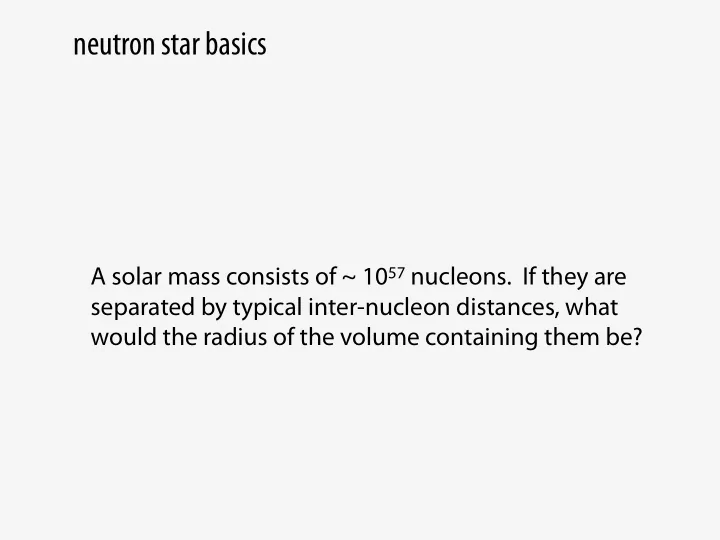

neutron star basics A solar mass consists of ~ 10 57 nucleons. If they are separated by typical inter-nucleon distances, what would the radius of the volume containing them be?
��� � � �� neutron star basics �� �� � � / � ∼ �� �� � � ∼ � �� · �� � ≈ � . � ≈ ∆ λ λ ≈ ��� ���
from nuclei to bulk matter ⇥ 2 Z 2 � N − Z E A ≈ − a V + a S A − 1/3 + a A + a C A 4/3 N + Z
����� ������� ���������� �� ��� ������ ���� ���������� ��� ������ ���������� �������� ���� �� ����� ��� ������ ��� ������� �� Thermodynamics near saturation density see review by Lattimer & Prakash ������� � = � . �� �� − � � ��� ������ �������� �� � = � � / ( � � + � � ) , � � = � � = �� . ε ( � , � ) = ε � ( � ) + ε � ( � )( � − � � ) � .
�� ����� ��� ��� ������ �������� � � � � � Why so neutron-rich? �� β ������������� � ∂ε � ∂ε � � = µ � − µ � = − µ � ∂ � � ∂ � � − ∂ε = ∂ � = � ε � ( � − � � ) . ��� ������������ ���������� µ � = ( � π � � � ) � / � � � , �� �� ��� � � − � � � � � � � + � π � � = ≈ � . �� ε � ��� ε � = �� ����
µ e � kT, m e c 2 Z 2 e 2 � kT a
µ e � kT, m e c 2 Z 2 e 2 � kT a
µ e � kT, m e c 2 Z 2 e 2 � kT a
illustration with a simple liquid-drop model (Mackie & Baym ’77, following Haensel & Zdunik ’90) neutron drip Ni (28) 18 Co (27) S n (MeV) Fe (26) Mn (25) 9 ➤ Cr (24) ➤ V (23) ➤ Ti (22) 0 ➤ Sc (21) ➤ ➤ ➤ Ca (20) ➤ ➤ ➤ ➤ ➤ K (19) ➤ ➤ ➤ Z ↑ ➤ ➤ ➤ ➤ Ar (18) ➤ ➤ ➤ ➤ ➤ ➤ ➤ ➤ Cl (17) ➤ ➤ ➤ ➤ ➤ ➤ ➤ ➤ ➤ S (16) ➤ ➤ ➤ ➤ ➤ ➤ ➤ ➤ ➤ P (15) ➤ ➤ ➤ ➤ ➤ ➤ ➤ ➤ ➤ Si (14) ➤ ➤ ➤ ➤ ➤ ➤ ➤ ➤ ➤ Al (13) ➤ ➤ ➤ 48 Mg (12) ➤ ➤ ➤ ➤ ➤ ➤ ➤ 44 46 ➤ ➤ ➤ ➤ Na (11) ➤ ➤ 40 42 ➤ ➤ Ne (10) 36 38 F (9) 32 34 O (8) 8 10 12 14 16 18 20 22 24 26 28 30 pycnonuclear reactions crust reactions Sato ’79; Haensel & Zdunk ’90; Gupta et al. ’07; Steiner ’12; Schatz et al. ‘13; Lau et al. (in prep)
Many of these reactions are within reach of FRIB
Disordered nuclear pasta, magnetic field decay, and crust cooling in neutron stars C. J. Horowitz, 1, ∗ D. K. Berry, 2 C. M. Briggs, 1 M. E. Caplan, 1 A. Cumming, 3 and A. S. Schneider 1 1 Department of Physics and Center for the Exploration of Energy and Matter, Indiana University, Bloomington, IN 47405, USA 2 University Information Technology Services, Indiana University, Bloomington, IN 47408, USA 3 Department of Physics, McGill University, 3600 rue University, Montreal QC, H3A 2T8 Canada (Dated: October 9, 2014)
Recommend
More recommend